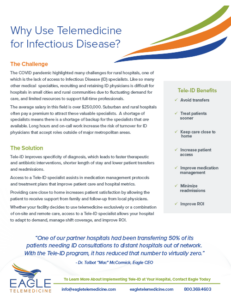At first glance, one might think that telemedicine wouldn’t be the best medium for diagnosing and treating patients with infectious diseases (IDs). There is, after all, nothing to “listen to” in conditions of sepsis, infected wounds from diabetes or other ailments, meningitis, osteomyelitis, methicillin-susceptible Staphylococcus aureus (MSSA) or other infections—nothing a stethoscope on a videoconferencing cart can pick up from the sound of a patient’s heartbeat or stomach.
But look again. Today’s videoconferencing cameras provide crystal-clear views of abscesses and other signs of an infectious disease. Results from cultures and other lab work are readily available to Tele-ID physicians by way of the patient’s electronic medical record (EMR). With the assistance of nurses with the patient on site, the physician has everything he or she needs to make a proper diagnosis, set up a treatment plan with antibiotics and track patient progress.
So telemedicine is actually a perfect medium for ID diagnosis and care—as borne out in a recent case study about our program at eight Ascension hospitals in north central Wisconsin. The program has been so successful since it began late last year—it has reduced to zero the number of out-of-system transfers of patients with infectious diseases—that it’s worth sharing some details here.
Challenge: Stronger Infectious Disease Support
The hospitals needed to find new ways to reduce the number of patients being transferred out of system. Hospitalists and specialty-care physicians on staff were becoming more vocal about the need for infectious disease support, especially after one infectious disease telehealth specialist left the region. Clinical leadership knew the gap in ID coverage was a major reason they were transferring significant numbers of their patients to out-of-network hospitals, sometimes a good distance away to facilities in Madison to get the ID consultation they needed.
Telephone consultations with specialists weren’t enough. “You need to be able to look at the wound to know how to deal with it,” said Dr. Vimarsh Raina, an experienced TeleHospitalist who is Ascension’s medical director for virtual care. He and Dr. Robyn Schertz, vice president of medical affairs, agreed that a Tele-ID program could be the answer.
Solution: Infectious Disease Transfers Reduced
Eagle Telemedicine’s infectious disease telemedicine program went live at Ascension St. Michael’s in Stevens Point, Wis., on Dec. 11, 2018, with rollout to Ascension St. Clare’s in Weston the following week. Implementation across the other hospitals in the region came easily in the new year, even with the multiple EMRs, systems and processes involved.
The facilities’ clinical teams saw an immediate impact: a meningitis patient who undoubtedly would have been transferred outside the system was able to be cared for locally using the videoconferencing system for specialist consultation. After a few months, it was clear that facilities which previously transferred 50 percent of their ID patients had reduced those transfers to zero.
It’s a remarkable achievement that has easily covered the costs of the program. “What we saved [by keeping the patients] far exceeded what we pay for the Tele-ID service,” said Dr. Schertz.
How does the program work? Dr. Rania Saleh, the Illinois-based physician who leads the Tele-ID program for the eight hospitals, typically sees patients via the two-way videoconferencing cart once they have been admitted to the hospital from the emergency department (ED). At that time, standard evaluations and lab workups have usually been done and are included in the patient’s EMR, along with any other notes from referring physicians. Dr. Saleh’s job is to guide the patient’s healing and recovery through the proper administration of antibiotics, as well as management of wound care and other protocols required for recovery from the infection.
Once patients are discharged, Dr. Saleh is available by phone to consult with the patient’s primary care physician should any questions arise.
Patient Acceptance is High
Acceptance by patients was immediate and crossed all age groups. “It has astounded all of us,” said Dr. Schertz. The patients appreciate the time the ID specialist spends with them on their home turf. Dr. Saleh’s visits with them might last 15 to 30 minutes—quite a difference from the brief, sometimes hurried and usually unscheduled visits from the ID specialists on call at the larger hospitals where patients typically would be transferred from the Ascension region. No matter how fine the specialist, the day’s commitments frequently cause these in-person visits to be less than satisfactory from the point of view of patients and their families.
In fact, patients have commented that they feel the videoconferencing visits with Dr. Saleh are more personal than some of the in-person visits they have experienced with specialists on previous hospital stays. Dr. Saleh’s visits are typically scheduled in advance, so family members can be present without having to wait all day in the patient’s room for “the doctor to show up.” Clinical staff members, too, have embraced the program, which Ascension credits to the quality of Dr. Saleh and the rest of the Eagle team.
The program has been so successful that Ascension St. Michael’s is considering setting up a clinic for outpatient telemedicine ID consultations to support primary care providers in meeting complex patient care needs, offering post-hospitalization follow-up and preventing readmissions.
Our Hospital Partners’ Success is the Story
Eagle Telemedicine saw amazing growth last year, with the addition of 84 new programs—a growth rate of 158 percent over 2017. We are proud of that record, but our growth rate isn’t really the story. What really deserves the spotlight are the successes of our hospital partners.
Those successes might come from our standard TeleHospitalist or TeleNocturnist services, or with TeleCardiology, TelePsychiatry, TeleNeurology, TeleStroke and other specialties that are in widespread use among the hospitals we serve. Or, they might happen with a less common but equally effective program—like our Tele-ID offering in north central Wisconsin.







